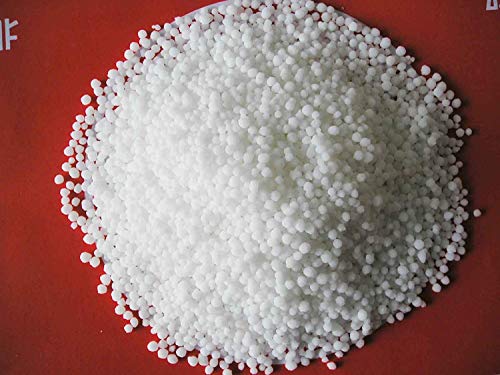-
NPK Calcium Nitrate Worlds top Imported Balanced Water Soluble Fertilizer for All Plants and Garden - 1KG
Regular price Rs. 249.00Regular priceUnit price / perRs. 499.00Sale price Rs. 249.00Sale -
Generic Calcium Nitrate. 100% Water Soluble Fertilizer 1Kg -
Regular price Rs. 100.00Regular priceUnit price / perRs. 499.00Sale price Rs. 100.00Sale -
Utkarsh Boronated CAN (900gm) (Boronated Calcium Nitrate)(set of 3)
Regular price Rs. 750.00Regular priceUnit price / perRs. 1,410.00Sale price Rs. 750.00Sale -
Calcium Nitrate 900gm
Regular price Rs. 225.00Regular priceUnit price / perRs. 500.00Sale price Rs. 225.00Sale -
Utkarsh CaLong (Calcium Ca 10% EDTA Chelated Fertilizers) (100% Water Soluble foliar Spray) Fruit and Vegetables (500gm)
Regular price Rs. 550.00Regular priceUnit price / perRs. 750.00Sale price Rs. 550.00Sale -
Utkarsh Magnesium Sulphate (900GM)(Epsom Salt)(MgSO4.7H2O) (Magnesium)-9.6% (Sulphur-12%)
Regular price Rs. 280.00Regular priceUnit price / perRs. 420.00Sale price Rs. 280.00Sale -
Which is most useful fertilizer after Urea and DAP?
Regular price Rs. 890.00Regular priceUnit price / perRs. 964.00Sale price Rs. 890.00Sale -
Sulfo life (Sulphur WDG, WP) 1 KG
Regular price Rs. 200.00Regular priceUnit price / perRs. 225.00Sale price Rs. 200.00Sale -
Superier (12kg)
Regular price Rs. 1,800.00Regular priceUnit price / per -
Utkarsh Boronated CAN (900gm) (Boronated Calcium Nitrate)(set of 2)
Regular price Rs. 530.00Regular priceUnit price / perRs. 940.00Sale price Rs. 530.00Sale -
GSFC, Sardar Boronated Calcium Nitrate Liquid Fertilizer (BCN Liquid Fertilizer) Pack of 1 L
Regular price Rs. 750.00Regular priceUnit price / perRs. 900.00Sale price Rs. 750.00Sale -
Katra Atal-Boron Ethanolamine-10%(100Ml) Nano Technology Based Flowering Booster for Plants Used in Garden and Farms.
Regular price Rs. 325.00Regular priceUnit price / per -
YaraVita Bortrac (Boron Ethanolamine) 1Ltr
Regular price Rs. 1,319.00Regular priceUnit price / per -
BACF Boron (B) and Salicylic Acid (SA) Liquid Boron Ethanolamine Fertilizers (500 ml)
Regular price Rs. 449.00Regular priceUnit price / perRs. 510.00Sale price Rs. 449.00Sale -
YaraVita Zintrac 700 Zinc 39.5% Liquid Spray Plant Growth Fertilizer for All Plants 1000 ML
Regular price Rs. 1,420.00Regular priceUnit price / perRs. 1,550.00Sale price Rs. 1,420.00Sale
Collection: Fertilizer balance in Chili crop
Integrated nutrient management (INM) in chilli cultivation is a holistic approach to nutrient management that combines the use of organic and inorganic fertilizers to improve soil fertility and crop productivity.
Role of soil texture
Soil texture plays an important role in chilli cultivation. Chilli plants prefer well-drained, loamy soils with a pH of 6.0 to 7.0. Heavy soils can lead to waterlogging and root rot, while sandy soils can leach nutrients easily.
Chemical fertilizers
Chemical fertilizers are inorganic fertilizers that provide nutrients to plants in a readily available form. They are commonly used in chilli cultivation to supplement the nutrients provided by organic fertilizers.
The main chemical fertilizers used in chilli cultivation are nitrogen (N), phosphorus (P), and potassium (K). N is essential for plant growth and development. P is essential for root growth and seed production. K is essential for water use efficiency and crop quality.
Biofertilizers
Biofertilizers are living microorganisms that can help to improve nutrient availability and uptake by plants. They are a valuable addition to INM programs for chilli cultivation.
Some examples of biofertilizers that can be used for chilli cultivation include:
- Rhizobium: Rhizobium bacteria form a symbiotic relationship with chilli plants and help them to fix atmospheric nitrogen.
- Phosphate-solubilizing bacteria: Phosphate-solubilizing bacteria help to solubilize phosphorus in the soil, making it more available to chilli plants.
- Potash-solubilizing bacteria: Potash-solubilizing bacteria help to solubilize potassium in the soil, making it more available to chilli plants.
Organic fertilizers
Organic fertilizers are derived from plant and animal materials. They are a good source of N, P, K, and other essential nutrients. Organic fertilizers also help to improve soil structure and water-holding capacity.
Some examples of organic fertilizers that can be used for chilli cultivation include:
- Farmyard manure
- Compost
- Green manure
- Crop residues
Nano fertilizers
Nano fertilizers are fertilizers that are made up of nanoparticles. Nanoparticles are smaller than 100 nanometers in size. Nano fertilizers are more efficient than traditional fertilizers because they are more easily absorbed by plants.
Research is ongoing to develop nano fertilizers for chilli cultivation. Nano fertilizers have the potential to increase chilli yield and reduce fertilizer costs.
Integrated nutrient management (INM) practices for chilli cultivation
Here are some INM practices that can be used for chilli cultivation:
- Apply a balanced dose of chemical fertilizers: The recommended dose of chemical fertilizers for chilli varies depending on the soil type and fertility status. It is important to get a soil test done to determine the fertilizer requirements of your field.
- Use biofertilizers: Biofertilizers can be applied to the soil or to the seeds. They can also be sprayed on the plants.
- Apply organic fertilizers: Organic fertilizers should be applied to the soil before planting and during the growing season.
- Rotate crops: Crop rotation helps to improve soil fertility and reduce pest and disease problems.
Benefits of INM in chilli cultivation
INM has a number of benefits for chilli cultivation, including:
- Increased crop yield
- Improved soil fertility
- Reduced environmental impact
- Reduced fertilizer costs
Conclusion
INM is an important approach to nutrient management in chilli cultivation. INM can help to improve crop yield, improve soil fertility, reduce environmental impact, and reduce fertilizer costs.
By following the INM practices outlined above, chilli farmers can improve the productivity and profitability of their crops.
















